Technology
DETAILS | ROTATIONAL MOULDING
During the design stage is important to consider all the details of the rotational moulding process. Some fundamental guidelines for the design are:
- avoid very large flat surfaces. The parts manufactured with this process are free to shrink while cooling: flat surfaces tend to curve.
- specify a nominal thickness value with an indication of minimum thickness allowed: typically variations may be around ± 20%, except in particular areas (flanges, stiffening ribs, vents, deep cores etc) where the variation may be much greater.
- check that the material required can be contained in the cavity, and if necessary consider the use of a Drop Box.
- Design deep cores and pockets so as to have a good heat flow. If thicker walls are required consider the use of air flow amplifiers.
- When designing, take into account the material heat expansion coefficient.
- keep zones that could be subjected to stress away from the parting line
- arrange the inserts to allow a good filling.
- remember that the material softening point of polyethylene is low (65°C – 150F). Parts that require higher values must be moulded in polyamide or polypropylene.
At the end of the design, the result will be a set of 2D and 3D drawings, so that the customer and the moulder can see the component to be produced and analyse the part and its function.
The drawings need to highlight all the details needed by the moulder.
